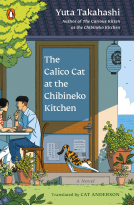
Preserving the Japanese Way
Traditions of Salting, Fermenting, and Pickling for the Modern Kitchen
by Nancy Singleton Hachisu
This title was previously available on NetGalley and is now archived.
Send NetGalley books directly to your Kindle or Kindle app
1
To read on a Kindle or Kindle app, please add kindle@netgalley.com as an approved email address to receive files in your Amazon account. Click here for step-by-step instructions.
2
Also find your Kindle email address within your Amazon account, and enter it here.
Pub Date Aug 11 2015 | Archive Date Aug 10 2015
Description
— Sandor Ellix Katz, author of The Art of Fermentation, Wild Fermentation, and other books
Preserving the Japanese Way, nominated for a 2016 James Beard Award in the International Cookbook category, introduces Japanese methods of salting, pickling, and fermenting that are approachable and easy to integrate into a Western cooking repertoire. Documentary-quality photo essays reveal the local Japanese communities that support these long-established preservation practices. It is by Nancy Singleton Hachisu, author of Japanese Farm Food.
Preserving the Japanese Way: Traditions of Salting, Fermenting, and Pickling for the Modern Kitchen offers a clear road map for preserving fruits, vegetables, and fish through a nonscientific, farm- or fisherman-centric approach. An essential backdrop to the 125 recipes outlined in this book are the producers and the artisanal products used to make these salted and fermented foods. The more than 350 arresting photos of the barrel maker, fish sauce producer, artisanal vinegar company, 200 hundred-year-old sake producer, and traditional morning pickle markets with local grandmas still selling their wares document an authentic view of the inner circle of Japanese life. Recipe methods range from the ultratraditional— Umeboshi (Salted Sour Plums), Takuan (Half-Dried Daikon Pickled in Rice Bran), and Hakusai (Fermented Napa Cabbage)— to the modern: Zucchini Pickled in Shoyu Koji, Turnips Pickled with Sour Plums, and Small Melons in Sake Lees. Preserving the Japanese Way also introduces and demystifies one of the most fascinating ingredients to hit the food scene in a decade: koji. Koji is neither new nor unusual in the landscape of Japan fermentation, but it has become a cult favorite for quick pickling or marinades. Preserving the Japanese Way is a book about community, seasonality as the root of preserved food, and ultimately about why both are relevant in our lives today.
A Note From the Publisher
We regret that this electronic galley is not available for Kindle viewing. The finished book will be available in print and ebook formats.
Available Editions
| EDITION | Other Format |
| ISBN | 9781449450885 |
| PRICE | $50.00 (USD) |
Average rating from 30 members
Featured Reviews
 Kaye T, Reviewer
Kaye T, Reviewer
Interesting take, and a wonderful book to just read. A nice take on the ways of a different culture, and the pictures were attractive and enhanced the book. Would highly recommend, although not sure if I will try the methods or not.
 Lili F, Reviewer
Lili F, Reviewer
First off, this book is a visual treat, full of beautiful photos of Japanese food, places, and people, if you like your cookbooks very specialized and pretty then you will love this book.
Sadly due to some really stupid food intolerances, I cannot eat much in the way of fermented food, and certainly no soy, but for all that I still enjoyed every moment I spent reading this book. See, I love traditional Japanese food, one of my favorite cookbooks from my earlier days was a book on country cooking in Japan, and the dishes I tried were delicious, this book mirrors the same traditional aesthetic that I love.
I also really liked how it was not just a book about food but also about the people who specialize in making the tools and ingredients, it was a beautiful look into both their's and the author's lives.
Even if you have no interest in fermenting foods, I recommend this book, doubly so if you love Japanese cooking and culture.
 Reviewer 252704
Reviewer 252704
I first began reading Japanese recipes and cookbooks after my youngest son moved to Japan. In particular, the pickling process and use was intriguing. When his fiance visited, I made pickles especially for her. Preserving the Japanese Way goes way beyond a cookbook. It is a cultural, even spiritual story of a Japanese way of life that much like ours in the U.S., was almost lost. Read this as much for Hachisu's story as for the recipes.
 Librarian 264282
Librarian 264282
This is a thorough and informative guide to pickling and preserving in a Japanese style. Will appeal to patrons interested in Japanese cooking, Fermentation, and food photography.
 Librarian 150434
Librarian 150434
I would recommend book. The pictures are great and steps are easy to follow. But, I still think it's for advance skills. I enjoyed because it's different canning and preserves.
 Leyla J, Reviewer
Leyla J, Reviewer
This is really a fabulous book, one that you can dip into when relaxing with lots of information about the food and the traditional methods of preserving. And one that you can try making some Japanese preserves, I must confess that when I first saw the book my interest was pricked, but I never thought I would make anything in the book, but the recipes are so do-able. The ingredients aren't hard to find and the methods are easy to follow. A really instructive and interesting book into the cooking, tradition and culture of a cuisine we love to eat. Now we can have a hand in making it ourselves.
 Michelle M, Reviewer
Michelle M, Reviewer
Someone is getting a copy of this book for Christmas. I haven't quite decided if it'll be for Hubby or Teenage Daughter, but this book needs to be in our kitchen. With our family's ongoing series of culinary dares, this book seemed like a good way to find out what some of those intriguing things on the shelves of Uwajimaya and Fubonn actually are.
There's so much more than food in this book. The author lives in a hundred year old Japanese farmhouse with her husband and family, and teaches an English immersion preschool. She describes her wooden buckets and barrels and collection of old cooking implements in loving details, explaining when and why traditional is better than modern plastic. The pictures are gorgeous and the instructions are clear.
And that's before I even start to think about the food that's the purpose for the book in the first place! I won't be pickling eggs, but there are plenty of recipes I want to try.
 Kaitlyn H, Reviewer
Kaitlyn H, Reviewer
First, let me start off by saying, the pictures in this cookbook are A-M-A-Z-I-N-G! It made me nostalgic for the country that I studied abroad in during my college years. Although, I absolutely love most of these flavors and styles of foods, I more than likely will not be able to recreate them due to lack of ingredients in the area (also the costs of what is around) as well as the space to do it. That being said, I totally would try if those circumstance change for me.
If you are up for trying new foods, then you really should check out this cookbook. Even if your not, this is worth reading just for the photos and the tidbits of Japanese culture that you find throughout.
Readers who liked this book also liked:
Kristin Link
Arts & Photography, Crafts & Hobbies, Outdoors & Nature
We Are Bookish
Mystery & Thrillers, OwnVoices, Teens & YA


















